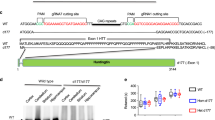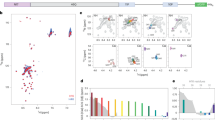Abstract
The expansion of a CAG repeat coding for polyglutamine in otherwise unrelated gene products is central to eight neurodegenerative disorders including Huntington's disease1. It has been well documented that expanded polyglutamine fragments, cleaved from their respective full-length proteins, form microscopically visible aggregates in affected individuals and in transgenic mice2,3,4,5,6,7. The contribution of polyglutamine oligomers to neurodegeneration, however, is controversial. The azo-dye Congo red binds preferentially to β-sheets containing amyloid fibrils8,9 and can specifically inhibit oligomerization10 and disrupt preformed oligomers. Here we show that inhibition of polyglutamine oligomerization by Congo red prevents ATP depletion and caspase activation, preserves normal cellular protein synthesis and degradation functions, and promotes the clearance of expanded polyglutamine repeats in vivo and in vitro. Infusion of Congo red into a transgenic mouse model of Huntington's disease, well after the onset of symptoms, promotes the clearance of expanded repeats in vivo and exerts marked protective effects on survival, weight loss and motor function. We conclude that oligomerization is a crucial determinant in the biochemical properties of expanded polyglutamine that are central to their chronic cytotoxicity.
This is a preview of subscription content, access via your institution
Access options
Subscribe to this journal
Receive 51 print issues and online access
$199.00 per year
only $3.90 per issue
Buy this article
- Purchase on Springer Link
- Instant access to full article PDF
Prices may be subject to local taxes which are calculated during checkout






Similar content being viewed by others
References
The Huntington's Disease Collaborative Research Group. A novel gene containing a trinucleotide repeat that is expanded and unstable on Huntington's disease chromosomes. Cell 72, 971–983 (1993)
Wellington, C. L. et al. Inhibiting caspase cleavage of huntingtin reduces toxicity and aggregate formation in neuronal and nonneuronal cells. J. Biol. Chem. 275, 19831–19838 (2000)
Kim, Y. J. et al. Caspase 3-cleaved N-terminal fragments of wild-type and mutant huntingtin are present in normal and Huntington's disease brains, associate with membranes, and undergo calpain-dependent proteolysis. Proc. Natl Acad. Sci. USA 98, 12784–12789 (2001)
Lunkes, A. et al. Proteases acting on mutant huntingtin generate cleaved products that differentially build up cytoplasmic and nuclear inclusions. Mol. Cell 10, 259–269 (2002)
Wellington, C. L. et al. Caspase cleavage of mutant huntingtin precedes neurodegeneration in Huntington's disease. J. Neurosci. 22, 7862–7872 (2002)
Perutz, M. Polar zippers: their role in human disease. Protein Sci. 3, 1629–1637 (1994)
Mangiarini, L. et al. Exon 1 of the HD gene with an expanded CAG repeat is sufficient to cause a progressive neurological phenotype in transgenic mice. Cell 87, 493–506 (1996)
Klunk, W. E., Pettegrew, J. W. & Abraham, D. J. Quantitative evaluation of Congo red binding to amyloid-like proteins with a β-pleated sheet conformation. J. Histochem. Cytochem. 37, 1273–1281 (1989)
Carter, D. B. & Chou, K. C. A model for structure-dependent binding of Congo red to Alzheimer β-amyloid fibrils. Neurobiol. Aging 19, 37–40 (1998)
Heiser, V. et al. Inhibition of huntingtin fibrillogenesis by specific antibodies and small molecules: implications for Huntington's disease therapy. Proc. Natl Acad. Sci. USA 97, 6739–6744 (2000)
Caughey, B. & Raymond, G. J. Sulfated polyanion inhibition of scrapie-associated PrP accumulation in cultured cells. J. Virol. 67, 643–650 (1993)
Howlett, D. R., George, A. R., Owen, D. E., Ward, R. V. & Markwell, R. E. Common structural features determine the effectiveness of carvedilol, daunomycin and rolitetracycline as inhibitors of Alzheimer β-amyloid fibril formation. Biochem. J. 343, 419–423 (1999)
Klunk, W. E., Debnath, M. L. & Pettegrew, J. W. Chrysamine-G binding to Alzheimer and control brain: autopsy study of a new amyloid probe. Neurobiol. Aging 16, 541–548 (1995)
Sanchez, I. et al. Caspase-8 is required for cell death induced by expanded polyglutamine repeats. Neuron 22, 623–633 (1999)
Beal, M. F., Hyman, B. T. & Koroshetz, W. Do defects in mitochondrial energy metabolism underlie the pathology of neurodegenerative diseases? Trends Neurosci. 16, 125–131 (1993)
Deckwerth, T. L. & Johnson, E. M. Jr Temporal analysis of events associated with programmed cell death (apoptosis) of sympathetic neurons deprived of nerve growth factor. J. Cell Biol. 123, 1207–1222 (1993)
Jaattela, M., Wissing, D., Kokholm, K., Kallunki, T. & Egeblad, M. Hsp70 exerts its anti-apoptotic function downstream of caspase-3-like proteases. EMBO J. 17, 6124–6134 (1998)
Wyttenbach, A. et al. Effects of heat shock, heat shock protein 40 (HDJ-2), and proteasome inhibition on protein aggregation in cellular models of Huntington's disease. Proc. Natl Acad. Sci. USA 97, 2898–2903 (2000)
Chai, Y., Koppenhafer, S. L., Bonini, N. M. & Paulson, H. L. Analysis of the role of heat shock protein (Hsp) molecular chaperones in polyglutamine disease. J. Neurosci. 19, 10338–10347 (1999)
Kazemi-Esfarjani, P. & Benzer, S. Genetic suppression of polyglutamine toxicity in Drosophila. Science 287, 1837–1840 (2000)
Hazeki, N., Tukamoto, T., Goto, J. & Kanazawa, I. Formic acid dissolves aggregates of an N-terminal huntingtin fragment containing an expanded polyglutamine tract: applying to quantification of protein components of the aggregates. Biochem. Biophys. Res. Commun. 277, 386–393 (2000)
Moulder, K. L., Onodera, O., Burke, J. R., Strittmatter, W. J. & Johnson, E. M. Jr Generation of neuronal intranuclear inclusions by polyglutamine–GFP: analysis of inclusion clearance and toxicity as a function of polyglutamine length. J. Neurosci. 19, 705–715 (1999)
Cummings, C. J. et al. Chaperone suppression of aggregation and altered subcellular proteasome localization imply protein misfolding in SCA1. Nature Genet. 19, 148–154 (1998)
Bence, N. F., Sampat, R. M. & Kopito, R. R. Impairment of the ubiquitin-proteasome system by protein aggregation. Science 292, 1552–1555 (2001)
Hurlbert, M. S. et al. Mice transgenic for an expanded CAG repeat in the Huntington's disease gene develop diabetes. Diabetes 48, 649–651 (1999)
Farrer, L. A. Diabetes mellitus in Huntington disease. Clin. Genet. 27, 62–67 (1985)
Li, H., Li, S. H., Johnston, H., Shelbourne, P. F. & Li, X. J. Amino-terminal fragments of mutant huntingtin show selective accumulation in striatal neurons and synaptic toxicity. Nature Genet. 25, 385–389 (2000)
DiFiglia, M. et al. Aggregation of huntingtin in neuronal intranuclear inclusions and dystrophic neurites in brain. Science 277, 1990–1993 (1997)
Onodera, O. et al. Oligomerization of expanded-polyglutamine domain fluorescent fusion proteins in cultured mammalian cells. Biochem. Biophys. Res. Commun. 238, 599–605 (1997)
Carter, R. J. et al. Characterization of progressive motor deficits in mice transgenic for the human Huntington's disease mutation. J. Neurosci. 19, 3248–3257 (1999)
Acknowledgements
We thank E. Signer, S. Lokey, M. Kirschner, N. Ayad, M. Kobori, O.Gozani, L. Yoo, R. Sanchez-Olea, A. Degterev and R. King for comments; T. Mitchison for advice; M. Takeuchi for technical assistance; and X.-J. Li, A. Kazantsev and C. Cepko for reagents. This work was supported in part by grants from the Hereditary Disease Foundation and the NIH (to J.Y.).
Author information
Authors and Affiliations
Corresponding author
Ethics declarations
Competing interests
The authors declare that they have no competing financial interests.
Supplementary information
Rights and permissions
About this article
Cite this article
Sánchez, I., Mahlke, C. & Yuan, J. Pivotal role of oligomerization in expanded polyglutamine neurodegenerative disorders. Nature 421, 373–379 (2003). https://doi.org/10.1038/nature01301
Received:
Accepted:
Issue Date:
DOI: https://doi.org/10.1038/nature01301
This article is cited by
-
Elucidation of Site-Specific Ubiquitination on Chaperones in Response to Mutant Huntingtin
Cellular and Molecular Neurobiology (2024)
-
Mutant Ataxin-3–Containing Aggregates (MATAGGs) in Spinocerebellar Ataxia Type 3: Dynamics of the Disorder
Molecular Neurobiology (2021)
-
Enhancement of Autophagy and Solubilization of Ataxin-2 Alleviate Apoptosis in Spinocerebellar Ataxia Type 2 Patient Cells
The Cerebellum (2020)
-
In vitro aggregating β-lactamase-polyQ chimeras do not induce toxic effects in an in vivo Caenorhabditis elegans model
Journal of Negative Results in BioMedicine (2017)
-
A chronic low dose of Δ9-tetrahydrocannabinol (THC) restores cognitive function in old mice
Nature Medicine (2017)
Comments
By submitting a comment you agree to abide by our Terms and Community Guidelines. If you find something abusive or that does not comply with our terms or guidelines please flag it as inappropriate.



